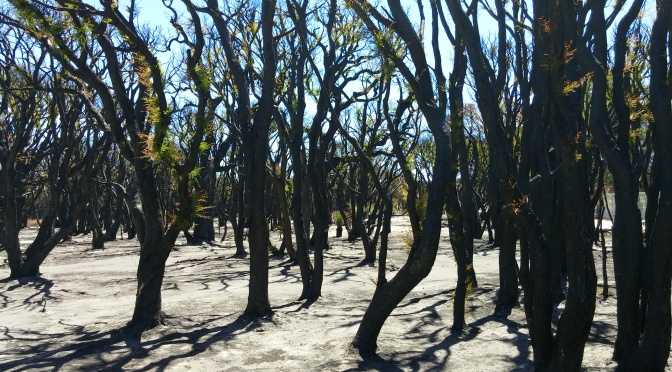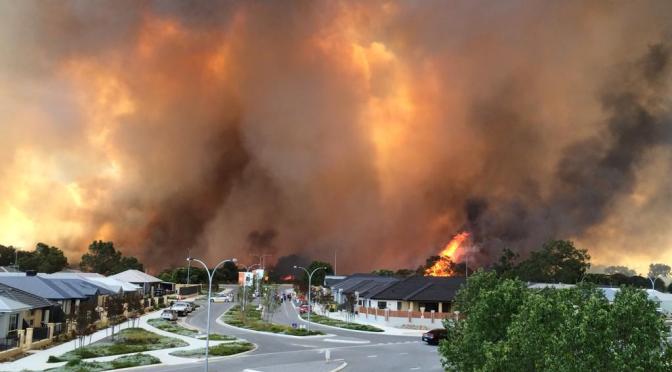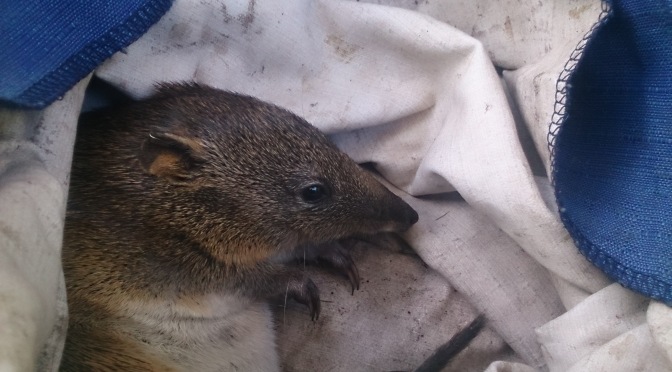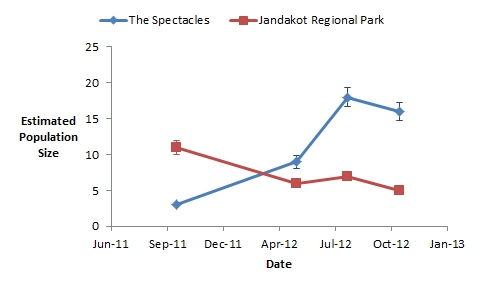Its now just over a month since a bushfire burnt through most of the Woodland Reserve at Whiteman Park and as I did promise an update and now have something to report here it is…
Continue reading Whiteman Park Bushfire Update: Looks like everyone’s been paying attention in fire drills.
Tag Archives: southern brown bandicoot
When your home burns down just before Christmas…
The words of that Band Aid song are running through me head… “Do they know its Christmas time at all?”. Of course they dont! They’re wild animals who don’t care about presents and egg nogg… Continue reading When your home burns down just before Christmas…
Getting quenda and bobtails to use underpasses: what works and what doesn’t
The project that I’ve been working on for the past couple of years looking at fauna underpasses is coming to an end, which means that it’s time to start producing some results. One of the big questions we were wanting to answer with this work is what factors encourage or discourage native fauna to use underpasses? There were a number of factors that we thought would potentially be important based on what we knew about the ecology and behaviour of the two main study species, the quenda and the western bobtail. These were: underpass length, underpass opening size, vegetation cover near the underpass entrances, furniture inside the underpasses, use by feral predators and the time since the underpasses were constructed. So what was important and what didn’t seem to matter? You’ll have to have a look at our report to find out.
Trapping Update: Mandurah Entrance Rd
My second last week of trapping was at my longest running site in this project which consists of Marlee Reserve and Black Swan Lake in Parklands. The Mandurah Entrance Rd was renamed Mandjoogoordap Drive a few years ago now, but the pre-construction name still sticks for me because I can pronounce it. I’ve now trapped this site 9 times since July 2009, so I’ve got a nice 4 years worth of data on the quenda and brushtail possum populations at this site. In this latest week of trapping I turned up 28 captures of 21 individual quenda, 6 brushtail possums, 2 brush-tailed phascogales, 3 rats and 10 magpies.
The capture of two brush-tailed phascogales was quite exciting as it has now been nearly 4 years since I last caught one in Marlee Reserve. Now all of a sudden two decided to get into traps in the one day (which was also a horribly stormy day as well).

The quenda population at Black Swan Lake is still managing to hold on, with 1 female caught at the lake in this trapping. This particular female was tagged last time I trapped at this site in spring 2012 so she seems to have found herself some good habitat protected from the foxes and cats that seem to be very plentiful around Black Swan Lake. Revegetation and habitat augmentation work is ongoing at this lake so hopefully the population can hang on and start to recover properly in the near future.
Trapping Update: The Spectacles and Jandakot Regional Park
Another long over due trapping update, this time from The Spectacles and Jandakot Regional Park. In the latest trapping at this site I managed to get 41 captures of 24 individual quenda, 6 brushtail possums, 1 chuditch, 1 western bobtail, 2 magpies and 6 rats. Obviously the capture of chuditch was particularly exciting which you can read about here. The other thing that was nice was to finally catch a female quenda at Jandakot Regional Park. It was only one though and so the sex bias in the quenda at this site is still very strong. The graph below shows the proportion of males that have been captured in the two population at this site since I first trapped in Spring of 2011. The really strange this is that there were close to equal numbers of males and females caught at Jandakot Regional Park in Spring 2011, but none at all in 2012 and now just one in the last trapping. At the Spectacles things are only slightly better with the proportion of males sitting fairly consistently between 70 and 80%. I still have no idea as the what would be causing this bias, it may be trap avoidance behaviour from females, but if it is this would be the only place that I’ve ever seen females behave in that way.


(Belated) Trapping Update: Walyungup/Cooloongup Lakes
The last several weeks have been rather busy and as a result updates to my blog have taken a back seat, but its time to catch up.
The last trapping at Walyungup and Cooloongup Lakes in Warnbro was a busy couple of weeks. Over the two weeks of trapping I had 72 captures of 46 individual quenda, 77 rats, 6 mouse mice and 1 feral cat.

The really nice thing that I’ve seen at this site over the last (nearly) 2 years is the massive increase in the quenda population over my trapping grids. The graph below shows how the quenda population has increased over the last 20 months, from an estimated 12 individuals in October 2011 to 55 currently.

In the first year after I started trapping the population increased by 250%, which is a pretty impressive growth rate for a marsupial population. My feeling about what is going on here is that I’ve been seeing the recovery of this population from the 2009 wildfire that burnt much of the vegetation on the western side of Lake Cooloongup and from the 2010 drought. Both of these events would have severely impacted on the quenda population and so its great to see them recovering so well.
The removal of another feral cat from the area brings the total number of cats that I have trapped and removed from this area to 4. There is still one more cat using the underpasses at this site, but I have one more chance in spring to catch and remove that one.
Trapping Update: Paganoni Swamp and Keralup
We’re back to the animals now, unless some more cool plants or fungi turn up 🙂
The last two weeks have been spent trapping at Paganoni Swamp and Keralup and a successful two weeks it was. The captures at the two sites went as follows:
Quenda: 4 at Paganoni Swamp, 15 at Keralup
Brushtail possums: 8 at Paganoni Swamp, 3 at Keralup
Brush-tailed phascogales: 3 at Paganoni Swamp
Bobtails: 1 at Paganoni Swamp
Rats: 3 at Paganoni Swamp, 24 at Keralup
The quite exciting development out of this trapping with the capture of the 4 quenda along the eastern boundary of Paganoni Swamp. I’ve been trapping in this area for 3 years now and have put in approximately 2500 trap nights prior to this trapping and in all of that time I have only caught 3 quenda in that area. So to capture 4 in one week is really exciting. Exactly where the animals have come from is unknown at this stage, the two possibilities are that they have moved into Paganoni from Keralup by using the fauna underpasses (which quenda have been doing more frequently over the past 6 months) or they may be from Paganoni and have expanded the areas that they are using so that they are now encountering my traps. There is a swampy area just to the west of my trapping grids where the quenda may be expanding from. Either way its really good to see them turning up in the area so hopefully I will see more of them when I come back to trap again in the spring.
Trapping 3 phascogales was also really nice, all three were female and they had not yet given birth, but they must only be a matter of days off from doing so now.
I’m starting at Walyungup and Cooloongup Lakes this week so it should be a case of lots more quenda and hopefully not too many rats.
Ninja Quenda
Things have been very quiet around this blog so far this year, mainly due to me being overrun with teaching commitments and family responsibilities which has meant that the fieldwork (fun) part of my job has been put on hold for a while. Things will be getting back to being more fun on that front shortly, but in the meanwhile I was sent a link to an amazing series of photo’s of two male quenda fighting in a backyard in suburban Perth. The photos were taken by Pam Cherriman and published online by her son Simon who is also a very skilled bird photographer.
The photos can be found here and are well worth a look.
Mandogalup: females still in short supply
I’ve gotten a bit behind with fieldwork updates again, but now that I’ve finished for the year its time to catch up.
A few of weeks ago it was the turn of The Spectacles and Jandakot Regional Park, or the Mandogalup site, to be trapped. It was another week of good numbers of captures with 21 bobtails caught and microchipped, 5 brushtail possums and 42 captures of 21 different quenda. Of the 21 quenda that were caught only 3 were female which unfortunately continues to extreme male bias that I’ve reported on from previous trapping efforts. All three females were also recaptures from previous trapping efforts as well so it appears that no new females are coming into the trapping areas. Just as a comparison of the 21 bobtails captured 8 were male and 13 were female which is much closer to what we would hope to see in terms of relatively even sex ratios. This lack of females, particularly at Jandakot Regional Park, also seems to be playing a role in the drop in numbers that I’ve seen in that area. The graph below shows the estimated population sizes for the quenda populations in the 8ha trapping grids for the two sides of the freeway. The population at the Spectacles has risen quite substantially since I started trapping, but the population at Jandakot Regional Park is following a fairly consistent downward trend. The last time a female quenda was caught at Jandakot Regional Park was September 2011, with nothing but males since.

Walyungup/Cooloongup Lake: Doing my bit for cat control
The past two weeks I have spent trapping at Walyungup and Cooloongup Lakes in Warnbro. This used to be a one week job, but with a huge increase in quenda captures and the large numbers of bobtails over spring I’ve needed to split the area and trap it in two halves.
It was another successful trapping in this area with 48 captures of 23 individual quenda, 63 western bobtails, 2 western bluetongues, 1 tiger snake, 54 rats, 7 mice and 2 feral cats.
The 2 feral cats were both ones that had been using the underpasses for at least the past 6 months, with one of them having taken to sleeping in the underpass as well in August. The photo below shows one of the feral cats curled up asleep on the microchip reader where it stayed on this particular day for 6 hours. At $6000 this would have to make it the most expensive cat bed in the world! Both of the cats that were captured were taken to the Cat Haven in Shenton Park where they are assessed to see if they can be re-homed, or if they are too aggressive then they are humanely destroyed.











